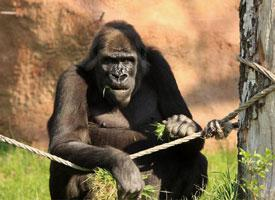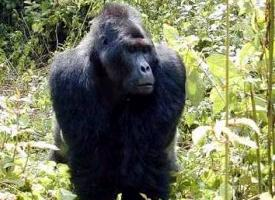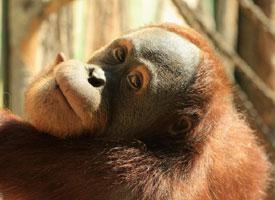
Greutăți și măsuri
| Înălțime la greabăn | 150 cm |
|---|---|
| Greutate | de la 140 la 150 kg |
Date biologice
| Durata de viață | de la 50 la 60 ani |
|---|---|
| Durata gestației | 8,5 m |
Starea de conservare
| Amenințat |
Descrierea animalului
The Western lowland gorilla (Gorilla gorilla gorilla) is a subspecies of the gorilla, which is the largest living primate. This remarkable animal is native to the dense, remote rainforests across Central and West Africa, inhabiting countries such as Angola, Cameroon, Central African Republic, Republic of the Congo, Democratic Republic of the Congo, Equatorial Guinea, and Gabon. Despite their formidable presence and strength, these creatures are known for their gentle and shy nature, displaying complex social structures and behaviors that have fascinated scientists and animal lovers alike.Western lowland gorillas are distinguished by their stocky body, broad chest, and long arms, which are much longer than their legs, aiding in their primary mode of locomotion, knuckle-walking. They have jet-black skin covered with coarse black hair, although adult males develop a characteristic silver sheen on their backs as they mature, earning them the title "silverbacks." This distinctive feature signifies maturity and leadership within their social groups, known as troops or bands. Adult males can weigh up to 180 kilograms (almost 400 pounds) and stand up to 1.7 meters (5.6 feet) in height when upright, making them the largest of the gorilla subspecies. Females are significantly smaller, roughly half the size of males.
The Western lowland gorilla's diet is predominantly herbivorous, consisting mainly of fruits, shoots, roots, and leaves. They play a crucial role in their ecosystem as seed dispersers, aiding in the regeneration of the forest. Their feeding behavior is essential for the survival and health of their habitats, demonstrating the interconnectedness of species within the rainforest ecosystem.
These gorillas live in groups that typically range from 2 to 20 individuals, led by a dominant silverback male. The silverback makes decisions for the group, mediates conflicts, and protects them from threats, including humans and leopards. The social structure within the group is complex, with strong bonds forming between members, particularly between mothers and their offspring. Gorillas communicate through a variety of vocalizations, body postures, and facial expressions, indicating the depth of their social interactions and emotional intelligence.
Reproduction in Western lowland gorillas is slow; females give birth to one infant after a gestation period of about 8.5 months, and the interval between births can be four years or more. The young are incredibly dependent on their mothers for the first few years of life, learning essential skills for survival within the group.
Despite their size and strength, Western lowland gorillas face significant threats from habitat destruction due to logging, agriculture, and mining, as well as from poaching and diseases like Ebola. These factors have led to a dramatic decline in their population, placing them on the critically endangered list according to the International Union for Conservation of Nature (IUCN). Conservation efforts are underway to protect these magnificent creatures and their habitat, including anti-poaching patrols, habitat preservation initiatives, and research to better understand their needs and behaviors.
In conclusion, the Western lowland gorilla is a fascinating and integral part of the Central and West African rainforests. Their existence is a testament to the complexity and beauty of the natural world, and their survival is crucial for the biodiversity of their ecosystem. Protecting these gentle giants and their habitat is not only essential for their future but also for the health of our planet.
Animale similare
Fotografii noi cu animale
Top 10 animale
- Dolphin gull (Leucophaeus scoresbii)
- Diana monkey (Cercopithecus diana)
- Moustached guenon (Cercopithecus cephus)
- Galápagos tortoise (Geochelone nigra complex)
- Russian tortoise (Testudo horsfieldii)
- Stone loach (Barbatula barbatula)
- Japanese macaque (Macaca fuscata)
- Greek tortoise (Testudo graeca)
- Common flying dragon (Draco volans)
- Vendace (Coregonus albula)


